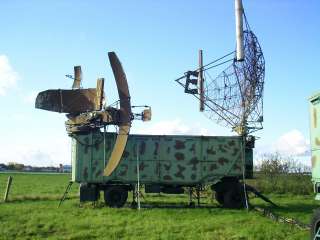RSP-6M
Description of the radar set, tactical-technical characteristics

Figure 1: RSP-6M
 Elektrobaukonzern WEGA
Elektrobaukonzern WEGA| Specifications | ||
|---|---|---|
| DRL-6M2 | PRL-6M2 | |
| frequency: | UHF-Band | X-Band |
| pulse repetition time (PRT): | 2 000 µs | 458 µs |
| pulse repetition frequency (PRF): | 500 Hz | 2 180 Hz |
| pulsewidth (τ): | 1.2 µs | 0.45 µs |
| receive time: | ||
| dead time: | ||
| peak power: | 180 kW | 80 kW |
| average power: | ||
| instrumented range: | 135 km | 40 km |
| range resolution: | 400 m | 200 m |
| accuracy: | 200 m; 1° | |
| beamwidth: | 2.5° | |
| hits per scan: | ||
| antenna rotation: | 10 min-1 | |
| MTBCF: | ||
| MTTR: | ||
RSP-6M
The precision approach radar system RSP-6M2 is designed to regulate aircraft traffic in the control area of an airfield and to enable approach to the runway of the airfield up to a minimum altitude of 150 to 200 m in poor visibility conditions. With the precision approach radar the further approach up to a decision height of 120 m is possible. The necessary commands for course and glide path correction are transmitted via radio telephony.
The equipment of the precision approach radar system RSP-6M2 includes:
- the cabin with the precision approach radar system PRLS-6M2 with all electronic equipment
necessary for the radar-controlled management of an airfield.
In the cabin of type 351-SB chassis type MAZ-5206) are located:
- the air surveillance radar DRL-6M2;
- the precision approach radar PRL-6M2;
- the automatic direction finder ARP-11;
- wired communications equipment and radio controls;
- PAeP-6M2 cabin with mobile autonomous power supply. It contains:
- three remote-controlled flight radio stations type R-863
- two diesel generators type AD-30T 230V/400Hz;
- a frequency converter of type WPL-30MD (50Hz → 400Hz);
- a three-phase mains voltage transformer of type PO-500 (400V → 230V);
- a control panel for power distribution and fuse protection;
- a range of spare parts.
Both primary radars also include an additional secondary radar channel, each operating in the same frequency band as the primary radar. The coding is similar to the IFF-Standard Mark Ⅹ, but contains additional time intervals for national purposes (see MSSR „Krona“).
Since the secondary radar components also use the main antenna, no additional antennas are required. The two long beams at the parabolic antenna as well as the small vertical parabolic antenna above the course antenna have only the purpose of a side lobe suppression and also serve the interference protection apparatus.

